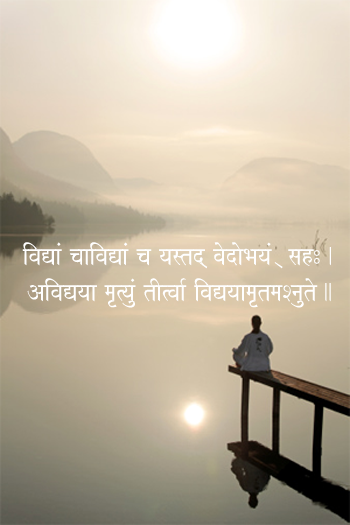Apr 18, 2025
Apr 18, 2025

Vidyam cavidyam ca yastad vedo – bhagyam saha,
Avidyaya mrtyum tirtva vidyaya – mrtam-asnute (11)
One, who knows Avidya and Vidya,
both together at the same time,
conquers death of physical body by Avidya
and attains immortality by Vidya.
Commentary
Sometimes the commentaries by intellectuals become too esoteric for the common people to understand and realise. The seer here explains in simple language the utility of physical science Avidya vis-a-vis spiritual science Vidya. In fact matter and spirit are conjoined. Work and worship go together. There is a balance of harmony in inner and outer dimensions of the two.
God permits personal and eternal bliss but also provides bread to all of us. Vidya guides to the first goal whereas Avidya does not let things happen but causes them to happen. The concept of “ism” has been foreign to Vedic thought. Vedanta is not an organised system of belief but of fundamental truth. It is the spirit of the individual that works towards realisation of this truth. It is the search for liberation which is the fundamental goal of our life. A farmer may worship the plough, a fisherman his boat, people whatever god and goddesses they propitiate for their aspect of life related to them, religion remains a personal affair. God is there and so the happiness of life can be attained by His grace. The medium is not important, our spirit of surrender to Him and dedicated work for a noble cause is the way out to realise Him in the blissful heart.
Vivekananda has said, "Our misery comes not from work, but by getting attached to something." One must work as the dictates comes from within and then, if it is right and good, society is bound to veer around. “We must plunge heart, soul and body into the works with purity, patience and perseverance.” He simply meant that the physical knowledge called Avidya, nescience, be put in use properly in cooperation with spiritual knowledge called Vidya in pursuit of the Infinite Consciousness. This is wisdom, the highest spiritual knowledge and with this will come the Bliss.
The seer emphasises on the synthesis of Vidya and Avidya or knowledge and not knowledge or nescience. It is just as the synthesis of science and religion. It is the real integration of head and heart; something like seeking unity in diversity. It is also relevant to the modern problems of the age. The seer asks everybody to be intensely practical in the scientific approach called Avidya, as well as in the spiritual world of deep enquiry called Vidya and see in that approach, the oneness and the harmony that will pervade the state of jeevan mukta. In fact Avidya arises in Vidya just as ripples arise in the ocean and Avidya dissolves as Vidya just as ripples are dissolved in water.
The seer wants us to resort to the understanding of non-duality as the Truth is non-dual. It is true that actions involve duality and we have to function in apparent duality. Let our nature partake of both duality and non-duality. The reality is neither duality, as it is the power of mind that creates this division, nor unity, as the concept of unity arises from anti thesis of duality. They are all notions and concepts and not the Infinite Consciousness.
The seer says that nothing is entirely physical or entirely metaphysical. One presupposes the other and explains another. What is matter - Avidya? It is only an infinitesimal part of the phenomenon of nature. The vast part is not nature. Avidya or physical sciences and material world of scientific rational is not non-inductive in religion and metaphysics. Dualism presupposes unity and non-dualism suggests dualism. This is needed for a helpful and healthy life style in the God’s world. It has been rightly said, “Compassionate yet not contemptuous, not avoiding pair of opposites, not jealous, neither intelligent nor non-intelligent, neither motivated nor non-motivated, we should live with equal vision and inner calm in full understanding. It is a fact that he sees the Truth who sees all things are strung in the Self as beads are stung on a thread and also the one who knows well “I am not the mind”.”
The knowledge based on Avidya only gives results and therefore is binding. It clings to the notion of the world. In reality, there is no difference between meaning of world, Brahman or the Infinite Self. The world is as true in relation to Brahman as the dream city is true in relation to waking consciousness. It goes to prove that there is no duality as the world and the cosmic consciousness are synonymous. In all such cases we have to realise our true nature by self –Enquiry. Avidya arises when we believe that there is something outside of knowledge and other than knowledge. Knowledge does not have an object to know. Knowledge is independent and eternal, beyond any description. When this truth is directly realised, there is perfect knowledge.
Jinan or knowledge is for awakening and enlightenment. Its contemplation is the means to such awakening. There is absolutely no relation or division between knowledge and the object of knowledge. In the verse, there is stress on the word “Ubhayagm saha”. It means both together. The theoretical knowledge of Vedanta doctrine cannot grant salvation to anyone. They are good as preparation to higher approach. Even the previous preparations are discarded after reaching the limit as we leave the rungs of ladder one by one while climbing. The actions are necessary for preparation only. We have not to delight in them but remain unaffected by them. So the case with Avidya and Vidya; both being concepts have to go and let only Self Knowledge shine.
Previous: Isha Upanishad - Shloka 10
Next: Isha Upanishad - Shloka 12
Image (c) Gettyimages.com
05-Jul-2011
More by : Dr. R. K. Lahri